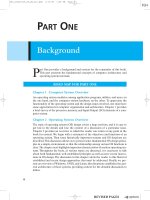Operating system internal and design principles by williams stallings chapter 011
Bạn đang xem bản rút gọn của tài liệu. Xem và tải ngay bản đầy đủ của tài liệu tại đây (354.21 KB, 64 trang )
I/O Management and Disk
Scheduling
Chapter 11
1
Categories of I/O Devices
• Human readable
– Used to communicate with the user
– Printers
– Video display terminals
• Display
• Keyboard
• Mouse
2
Categories of I/O Devices
• Machine readable
– Used to communicate with electronic
equipment
– Disk and tape drives
– Sensors
– Controllers
– Actuators
3
Categories of I/O Devices
• Communication
– Used to communicate with remote devices
– Digital line drivers
– Modems
4
Differences in I/O Devices
• Data rate
– May be differences of several orders of
magnitude between the data transfer rates
5
6
Differences in I/O Devices
• Application
– Disk used to store files requires file
management software
– Disk used to store virtual memory pages
needs special hardware and software to
support it
– Terminal used by system administrator may
have a higher priority
7
Differences in I/O Devices
• Complexity of control
• Unit of transfer
– Data may be transferred as a stream of bytes
for a terminal or in larger blocks for a disk
• Data representation
– Encoding schemes
• Error conditions
– Devices respond to errors differently
8
Performing I/O
• Programmed I/O
– Process is busy-waiting for the operation to
complete
• Interrupt-driven I/O
– I/O command is issued
– Processor continues executing instructions
– I/O module sends an interrupt when done
9
Performing I/O
• Direct Memory Access (DMA)
– DMA module controls exchange of data
between main memory and the I/O device
– Processor interrupted only after entire block
has been transferred
10
Relationship Among Techniques
11
Evolution of the I/O Function
• Processor directly controls a peripheral
device
• Controller or I/O module is added
– Processor uses programmed I/O without
interrupts
– Processor does not need to handle details of
external devices
12
Evolution of the I/O Function
• Controller or I/O module with interrupts
– Processor does not spend time waiting for
an I/O operation to be performed
• Direct Memory Access
– Blocks of data are moved into memory
without involving the processor
– Processor involved at beginning and end
only
13
Evolution of the I/O Function
• I/O module is a separate processor
• I/O processor
– I/O module has its own local memory
– Its a computer in its own right
14
Direct Memory Access
• Processor delegates I/O operation to the
DMA module
• DMA module transfers data directly to
or form memory
• When complete DMA module sends an
interrupt signal to the processor
15
DMA
16
DMA Configurations
17
DMA Configurations
18
Operating System Design
Issues
• Efficiency
– Most I/O devices extremely slow compared
to main memory
– Use of multiprogramming allows for some
processes to be waiting on I/O while
another process executes
– I/O cannot keep up with processor speed
– Swapping is used to bring in additional
Ready processes which is an I/O operation
19
Operating System Design
Issues
• Generality
– Desirable to handle all I/O devices in a
uniform manner
– Hide most of the details of device I/O in
lower-level routines so that processes and
upper levels see devices in general terms
such as read, write, open, close, lock,
unlock
20
21
I/O Buffering
• Reasons for buffering
– Processes must wait for I/O to complete
before proceeding
– Certain pages must remain in main memory
during I/O
22
I/O Buffering
• Block-oriented
– Information is stored in fixed sized blocks
– Transfers are made a block at a time
– Used for disks and tapes
• Stream-oriented
– Transfer information as a stream of bytes
– Used for terminals, printers, communication
ports, mouse and other pointing devices, and
most other devices that are not secondary
storage
23
Single Buffer
• Operating system assigns a buffer in
main memory for an I/O request
• Block-oriented
– Input transfers made to buffer
– Block moved to user space when needed
– Another block is moved into the buffer
• Read ahead
24
Single Buffer
• Block-oriented
– User process can process one block of data
while next block is read in
– Swapping can occur since input is taking
place in system memory, not user memory
– Operating system keeps track of assignment
of system buffers to user processes
25









